Menu
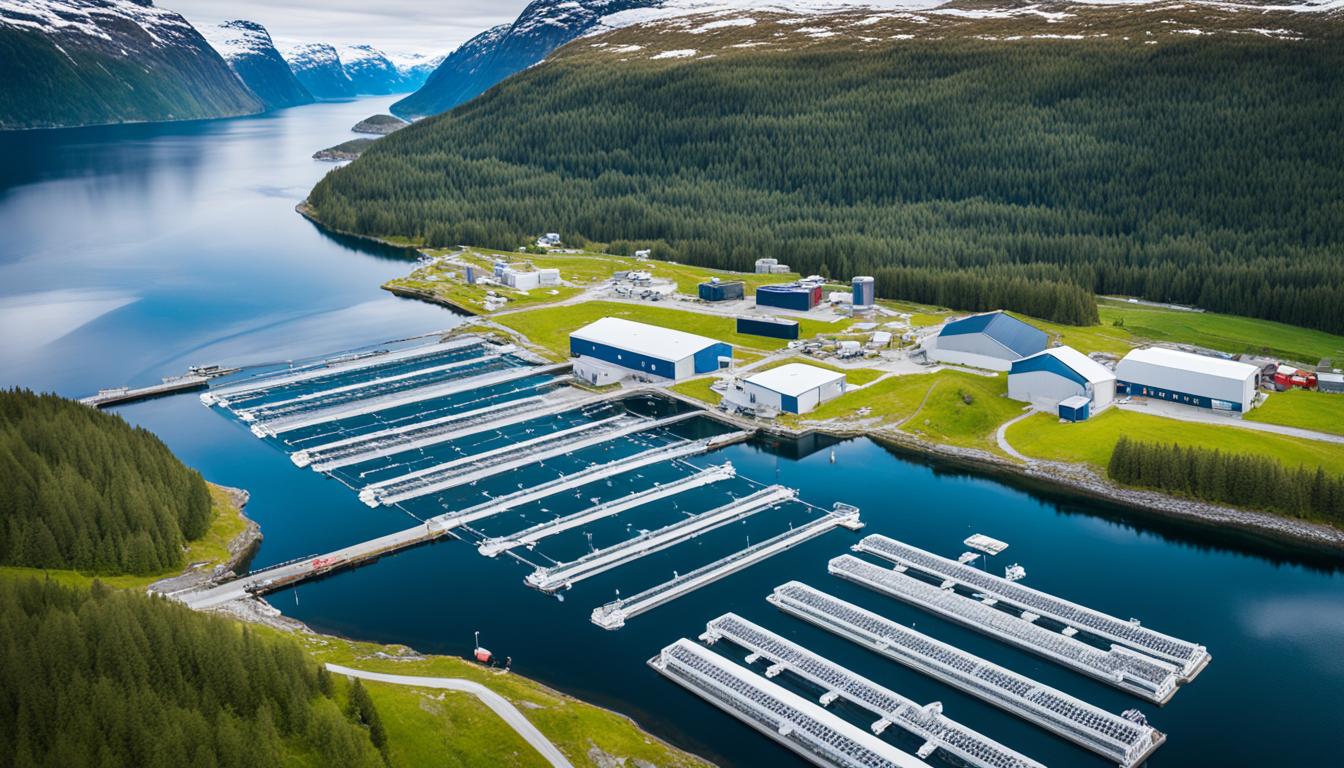
By 2050, it’s estimated the world’s population will hit 9.7 billion. Meeting the food demand will be crucial. Fish farming in Norway shows how advanced technology can tackle various challenges while being sustainable. It uses the country’s diverse coast and deep fishing history well. The aquaculture industry in Norway is leading in using technology to fight pollution, sea lice, and to create sustainable fish feed.
Glitne’s land-based farms are helping against environmental issues. Also, Harbour’s electric pulses fight sea lice, and Stingray Marine Solutions use AI and lasers for better parasite control. These efforts prove Norway’s devotion to eco-friendly innovation.
In the last decade, the production of fish meal and oil decreased by 50%. This highlights the need for new, sustainable alternatives. Norway is turning to solutions like C-Feed’s copepod farming for fish feed. They’re also using advanced methods for sea lice control with AI from Fishency Innovation and other methods.
These methods are key not just for fish farming’s sustainability. They also help keep marine ecosystems in balance. This supports wild fish and reduces the local impacts of aquaculture. Examples include SalMar’s Ocean Farm 1 and EVN’s Autonomous Fish Farming Vessel. These projects show Norway’s leading role in sustainable aquaculture.
Fish farming is a key part of Norway’s plan for secure and sustainable food. By 2022, there were 218 aquaculture companies in Norway. Most of these, 165, focused on salmon and rainbow trout. This shows a commitment to sustainable aquaculture practices that make good use of the sea’s resources.
The industry has grown a lot. For example, the value of fish caught went from NOK 8.6 billion in 1998 to NOK 106.5 billion in 2022. This rise proves the success of using advanced fish farming techniques. These techniques lower harm to the environment while making sure the output is high.
In 2022, aquaculture made up 73% of Norway’s seafood exports. This included 1.3 million tons of seafood sold for NOK 111.3 billion. The government’s aim is to raise salmon and trout production five times by 2050. This growth will happen with new fish farming techniques tackling sea lice and pollution.
In 2023, about 1,400 jobs were put on hold because of a new tax. But, the industry kept moving forward. It focused on eco-friendly methods like using aquaculture systems that recycle water and better food for the fish. These steps help use less food, which in turn, reduces pollution.
Normally, 25% of salmon food comes from the sea. But, the industry is changing by using more plant-based food. Now, experts say the salmon farms give back more marine protein than they take. This shows that the sustainable aquaculture practices in Norway are working well. They aim to support the growing need for food globally and protect the planet.
Below, you can see a table summarising key statistics for Norway’s aquaculture sector:
| Year | Company Focus | Total Seafood Export Value (NOK) | Seafood Export Volume (Tons) | First-Hand Value of Farmed Fish (NOK) |
|---|---|---|---|---|
| 2022 | Salmon, Rainbow Trout, Other Species | 111.3 Billion | 1.3 Million | 17 Billion |
| 1998 | Various | 8.6 Billion | — | — |
Norway’s aquaculture sector is showing the way in innovation and efficiency. It is working hard to grow production while protecting the environment. The actions taken aim at keeping a balance between nature and business.
Norway’s aquaculture sector blends old fishing traditions with new tech and green practices. This mix has made it a key player in the seafood world. Thanks to this, the country remains rich in culture and economically strong.
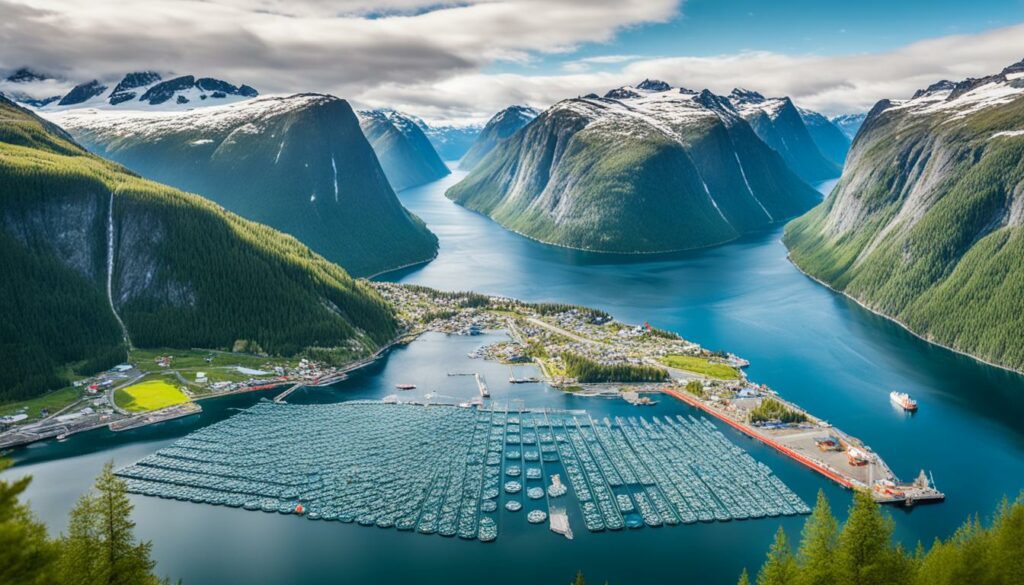
Norway’s fish farming began ages ago, blending tradition with science. This deep foundation helps produce over 600,000 tonnes of fish a year. Most notably, Norway is known for its Atlantic salmon farming, leading the global seafood industry.
The country’s fish farming isn’t just significant culturally but economically too. In 2018, it churned out 4 million tonnes of fish. This helps fill 77% of global seafood needs, powering Norway’s economy.
Between 2008 and 2018, Norway’s fish production went up 17% and its value by 104%. This shows a big leap forward in its industry. As a major net exporter, its seafood is in high demand worldwide.
Investments in fishing fleets have also grown, highlighting the sector’s economic impact. Norway’s commitment to sustainable practices and supporting its fishers shows its industry is both modern and respectful of its roots. This helps Norway keep its place as a top seafood supplier globally.
As the world’s population moves towards 10 billion by 2050, Norway is key in meeting the need for seafood. It does this by using advanced technology in fish farming. This tech includes automated feeding and underwater sensors. These help make fish farming both sustainable and efficient.
Automated feeding is a big step in how we farm fish. It makes sure fish get the right amount of food, preventing waste. This not only helps Norway’s fish farming be more profitable. It also fits well with taking care of the environment.
Underwater sensors are crucial for sustainable fish farming. They use sophisticated technology to check things like fish size and pests in the water. This real-time information is vital for keeping the fish healthy. It also helps in taking good care of the environment while farming fish in Norway.
The fish farming industry in Norway has long battled sea lice. But, unique technologies are now at play to tackle this issue. These advancements reflect a strong aim for sustainable practices in fish farming.
The Harbor Fence, using electric pulse tech, is a game-changer. It kills sea lice without harming the fish. This method is a milestone in innovative fish farming Norway by offering a gentle, yet effective, approach.
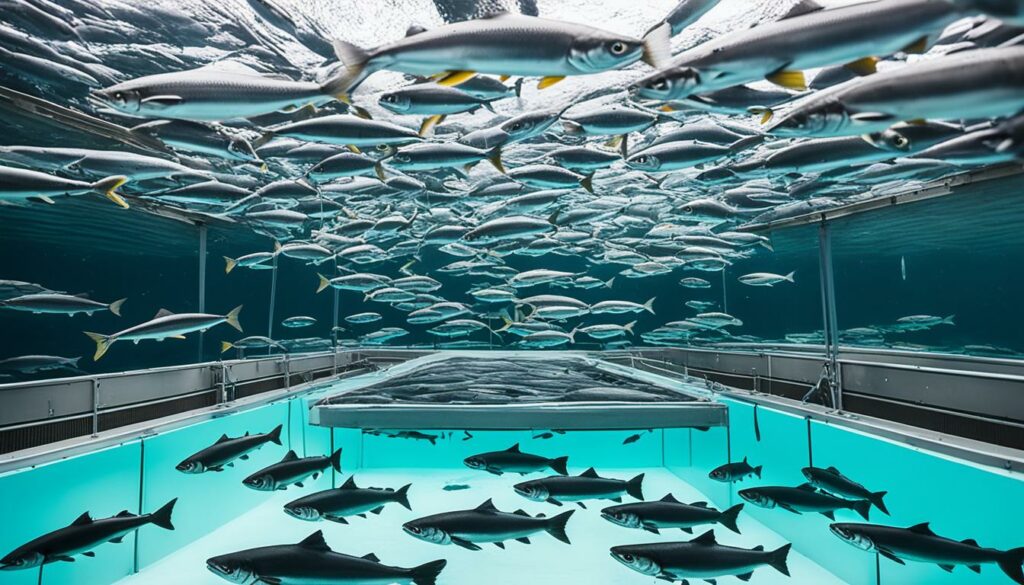
Stingray Marine Solutions has a breakthrough with laser precision. This tech eradicates sea lice with unmatched accuracy, through the use of AI for precise scanning. It showcases how sustainable aquaculture practices are moving forward, by limiting chemical use and reducing environmental impact.
Fishency Innovation leads with AI for early sea lice detection. It uses high-res imaging to spot sea lice sooner, without handling the fish. This method is much better than the old way of checking only a few fish samples. The integration of AI offers a wider and less disturbing method for dealing with sea lice in fish farming Norway.
These new technologies highlight Norway’s proactive stance on sustainable aquaculture practices. By using state-of-the-art solutions to fight sea lice, Norway is showing the way in modern aquaculture.
Land-based fish farming in Norway is leading the way in green aquaculture. It focuses on techniques that reduce harm to the environment. Norway’s efforts show the world how to produce fish in a smart, earth-friendly way.
Glitne is at the forefront with its unique ways of farming halibut on land. This keeps harmful sea lice and diseases away. The farm uses systems that recycle nearly all its water. This method is a big win for caring for nature. By growing halibut on land, Glitne proves that fish farming can be both profitable and gentle on the planet.
C-Feed stands out by producing a top-quality feed for young fish that’s friendly to the environment. They make it from copepods, tiny creatures full of good stuff like proteins and Omega-3s. This choice is not just healthy for the fish, it also cuts down on pollutants often found in fish farming.
“Integrating C-Feed’s starter product into land-based fish farming regimens illustrates a commitment to both efficiency and ecological balance. This synergy between innovative feed solutions and controlled aqueous environments heralds a new era for sustainable aquaculture practices in Norway and beyond.”
Glitne and C-Feed work together, showing how well land-based fish farming can be. They pay a lot of attention to keeping the water clean and lowering their environmental impact. Their work acts as a guide for others around the world in responsible fish farming. With these sustainable ways, fish farming in Norway is growing, making the country a leader in aquaculture.
Offshore fish farming is becoming a key player in sustainable aquaculture and improving Norwegian fish output. In moving operations to the open sea, Norway tackles issues like limited space and the impact on the environment near the coast.
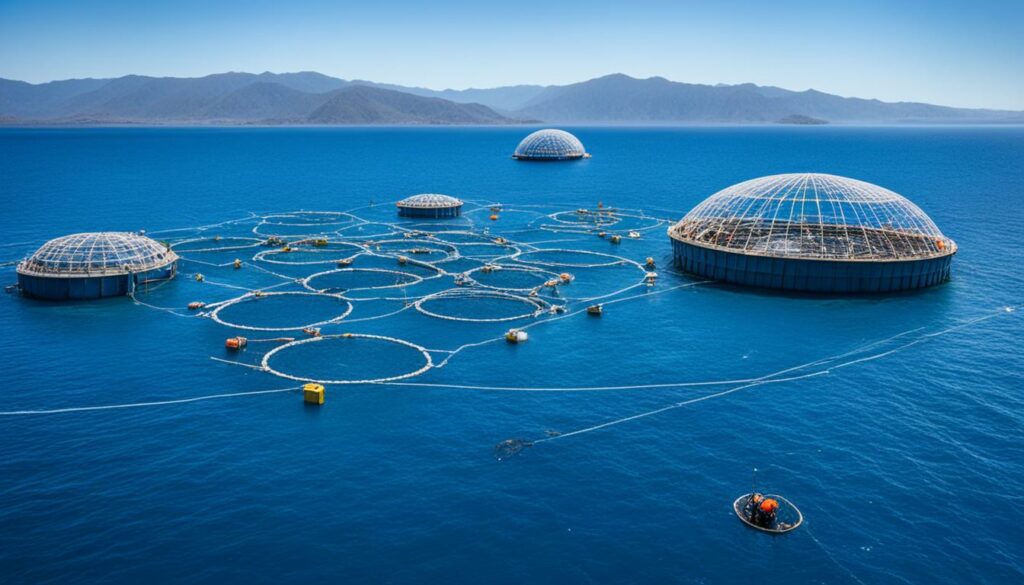
SalMar’s Ocean Farm 1 marks a big step in offshore fish farming. This large-scale pilot site boosts production without adding much to the usual harm done by fish farms near the coast. It shows Norway’s dedication to making aquaculture greener.
EVN’s self-sailing fish farm vessel is just as impressive. It uses advanced tech to operate without constant human hands, lessening pressure on the coast’s ecosystems. It’s packed with tools to keep an eye on fish health and the water’s condition, pushing Norwegian fish farming towards a more efficient, planet-friendly future.
Three sea zones in Norway—Trænabanken, Frøyabanken North, and Southern Norskerenna—are special offshore aquaculture places. They’re where new ideas and projects are put to the test, with the aim of making offshore fish farming better and bigger.
A study shows that offshore aquaculture could create lots of value and jobs, with 13.9 billion NOK (about USD 1.65 billion) in one busy year. Looking ahead to 2050, a report predicts it could bring in NOK 100 billion every year, supporting many jobs in Norway.
Norwegian aquaculture suppliers are excited about offshore fish farming for its growth potential, at home and abroad. For example, the Green Platform Initiative has put NOK 96 million (about USD 11 million) to back offshore aquaculture projects. This shows the state is investing heavily in this new area.
*Closed system fish farming* is becoming vital in *marine aquaculture Norway*. It aims to reduce the harm to the environment from regular farming. By tackling waste and disease, it offers a green path for the industry.
Its use deals with problems related to traditional farming. This includes managing waste better and controlling diseases. It’s a sustainable answer for the future.
The Marine Donut is a futuristic step in *closed system fish farming*. Developed by Bluegreen Technologies, it boosts water quality. It treats up to 99.9% of its water for reuse, marking a big move in using resources better.
These innovations are key in separating the farms from the wild. They help avoid issues like salmon lice and genetic mix-ups. This step is vital for both the farms and the environment.
FishGLOBE is making waves in *marine aquaculture Norway*. It’s a mobile unit built for top efficiency and moving easily. The round, mobile units represent a big change in flexible farming. They can work in different places, preventing sea lice and looking after the fish’s health properly.
| Innovation | Company | Key Feature | Impact |
|---|---|---|---|
| Marine Donut | Bluegreen Technologies | 99.9% Water Recycling | Optimised Resource Use, Enhanced Fish Health |
| FishGLOBE | FishGLOBE | Mobile Closed Units | Inflexible Deployment, Reduced Sea Lice |
The fish farming regulations Norway were established by the Norwegian Aquaculture Act. This law began on January 1, 2006. It aims for the fish farming industry to be profitable and kind to the environment. The act’s goal is to help the aquaculture sector grow sustainably and add value to coastal areas.
The key change this new law brings is replacing older regulations. This makes it easier for fish farmers to do business in a way that helps both society and the economy.
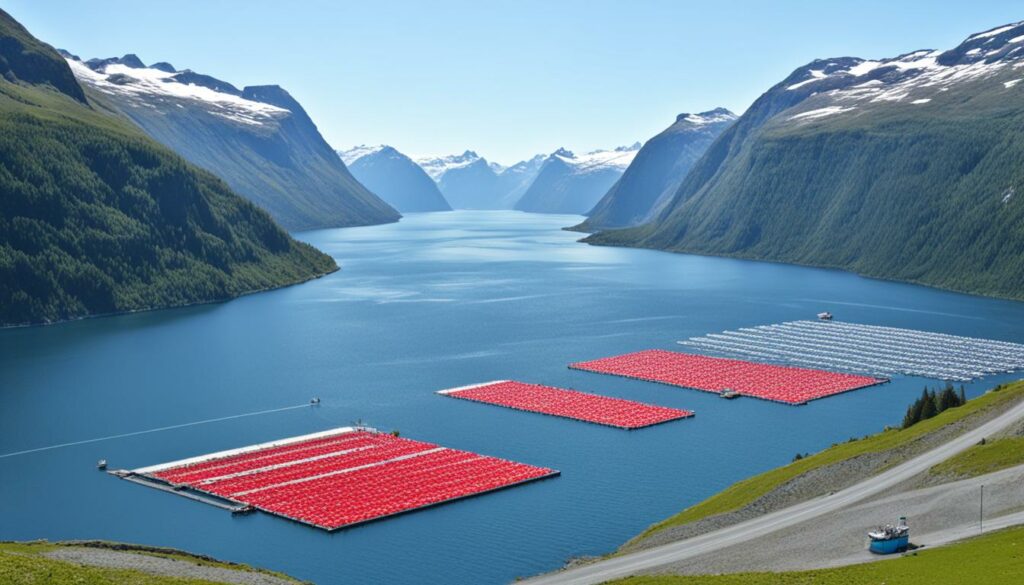
In Norway, there are many rules to ensure farming fish is sustainable. Companies can now easily buy, sell, or use their business as a guarantee for loans. This is because the government is reducing how much they control who owns fish farms. This change means businesses can operate more flexibly.
Setting up a fish farm has also become simpler. The process is now quicker, with better deadlines. This makes starting an aquaculture business more efficient.
Now, getting a licence to farm fish like salmon or trout can be by lottery or auction. This reduces waste and helps choose the best candidates. The law is very clear about saving the environment. It makes sure everyone in coastal areas is happy, while protecting nature.
Since 1985, fish farming in Norway has grown a lot. It’s gone from small to big, and from local to industrial. The changes have touched on farm ownership, technology, and how businesses are run. The law also focuses on battling sea lice, which is a big threat to both farmed and wild fish. Norway has set strict rules, like allowing just 0.2 female lice per fish. This law is much tougher than in countries such as Canada, Ireland, and Scotland.
Wholly, Norway is committed to making aquaculture a strong and green industry. This effort includes using the latest ideas and solid laws.
Norwegian fish farming is always improving. It focuses on ways to grow fish that are good for the environment. Norway uses many methods to grow fish well without harming nature.
In Norway, a lot of fish are grown using net-pens. Fish are kept in large nets in the sea. This helps them grow in conditions similar to the wild. It’s good for the fish’s health and growth.
But, net-pen farming faces challenges. For example, fish can get sea lice, and diseases might spread. So, farmers are always trying to find better ways to do this. They need to keep a close eye on the fish in the pens.
Recirculating Aquaculture Systems (RAS) are a very sustainable way of growing fish. They use a closed system to keep and clean water. This method helps keep the oceans clean by not wasting water or polluting it with harmful chemicals.
RAS also helps farmers control the water where the fish live. This means they can make sure the fish have the best conditions for growth. It lowers the chances of harmful germs affecting the fish too.
| Technique | Advantages | Challenges |
|---|---|---|
| Net-Pen Farming | Natural living conditions, cost-effective | Sea lice, disease spread, environmental impact |
| RAS | Water recycling, reduced effluents, controllable environment | High initial investment, technical complexity |
Norway’s fish farming methods are leading the world. By using advanced techniques, it grows fish in a way that’s good for the planet. These innovations keep Norway ahead in sustainable farming.
Norway’s leading fish farming industry is up against tough environmental hurdles. It aims to stay on top globally in aquaculture. To tackle this, firm steps on pollution control and reducing fish escapes are crucial.
Managing pollution carefully is key in aquaculture’s fight against environmental issues. Norway, home to 3% of the world’s fish farms, uses top tech to cut down waste. Remarkably, leftover waste from these farms powers nearly 600,000 homes every year. This shows how turning waste to energy benefits the environment as well.
What’s more, getting phosphorus out of the farm waste could not only cut waste but also produce 11,000 tonnes of material for fish feed. This step highlights Norway’s focus on using sustainable methods in fish farming.
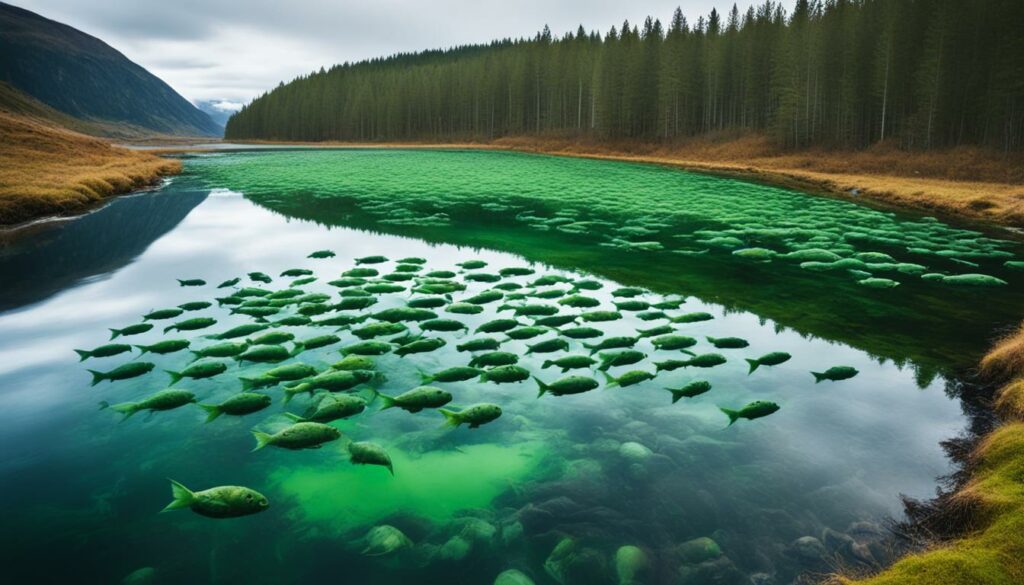
Fish getting away from aquaculture setups is a big problem in Norway’s fish farming. About 200,000 salmon break free each year, risking wild fish. Norway is fighting back with strict rules and pushing for systems keeping fish secure.
These steps also beat infections like sea lice, making things safer for both farm-raised and wild fish. Norway’s proactive approach and smart solutions put it at the forefront. It tackles aquaculture’s tough challenges while keeping its practices safe and sustainable.
Marine aquaculture in Norway is working hard to feed fish sustainably. They are looking for new marine ingredient substitutes and feed types. This way, they protect the sea and support sustainable growth.
The use of marine ingredient substitutes is growing in Norway’s aquaculture. Norwegian salmon feed is now non-GMO and free from antibiotics. It’s sourced carefully to lessen the usual harm on the environment.
Farmers in Norway have also stopped buying soya from irresponsibly farmed sources. They don’t want to support practices that harm important habitats.
Norway is making big changes to what they feed their fish. They are using things like microalgae and oils from plants instead. These new options are good for the fish and the environment.
The fish-to-water ratio in salmon farms is highly balanced, at 2.5% to 97.5%. This shows Norway’s focus on innovative and sustainable practices in aquaculture.
In 2022, Norwegian seafood, especially salmon, reached huge export levels. The U.S. has seen an 87% increase in salmon imports from Norway. This shows the world values Norway’s sustainable and efficient feeding practices.
Norwegian salmon farmers often rank high in the Coller FAIRR Protein Producer Index. This proves they excel in taking care of the environment and in social and governance issues too.
Salmon farming in Norway is top notch, known around the globe for its high quality and innovative methods. Since the 1970s, the country has been the leader in raising Atlantic salmon in farms. They’ve seen amazing growth thanks to focusing on sustainable ways and using new technology. These efforts ensure the fish are well taken care of.

Norway takes the safety of its fish very seriously, with strict rules and checks in place. What’s really impressive is that for the past 20 years, no antibiotics have been found in the farmed salmon. Almost all the salmon are raised without antibiotics, thanks to good vaccines and cleanliness rules. This has seen a massive drop of 99% in antibiotic use since the 1990s.
To keep the fish healthy and happy, the amount of fish compared to the water they swim in is closely watched. Norwegian fish farms make sure fish make up only 2.5% of the environment, with the rest being water. They feed the fish dry granulated food that’s 70% from plants and 30% from the sea. This way of feeding is not only good for the fish but also the environment.
Norway is also tackling challenges like sea lice in smart ways, such as using AI and lasers. They’ve been checking the fish for things like heavy metals for the last ten years, and the levels are always safe. This shows Norway’s strong commitment to making their aquaculture sustainable and producing salmon at the highest quality.
In 2019, the Norwegian fish industry made a huge economic impact by adding 69 billion NOK to the country’s GDP. It’s not just about the fish farming itself. There were also 33 billion NOK made in other fields because of it. This industry doesn’t just provide direct jobs but also boosts the economy in many other ways.
With 14 million meals of Norwegian salmon eaten every day, the world relies heavily on this seafood. Norway sets an example for how to grow food in a way that is good for the environment and meets high quality standards. This plays a big part in making sure there’s enough safe food for everyone worldwide.
| Key Statistics | Details |
|---|---|
| Antibiotic Use (2016) | 212 kilos, 0.14 grams per metric ton of salmon |
| Fish-to-Water Ratio | 2.5% fish, 97.5% water |
| Employment Growth (2016-2018) | 28%, approximately 8,300 people |
| Economic Contribution (2019) | 69 billion NOK to GDP, 33 billion NOK from supporting industries |
| Global Reach | Exports to over 100 countries, 14 million daily servings |
In Norway, marine aquaculture shows how a nation can lead with new ideas and care for the environment. They use modern tech like data analytics and IoT sensors to make their work smarter. This way, they protect the oceans while making sure the seafood they produce is top quality. This approach is why Norwegian seafood is well-loved around the world.
Norway is home to 218 aquaculture companies that focus mainly on salmon and rainbow trout. The value of the fish they harvest went from NOK 8.6 billion in 1998 to NOK 106.5 billion in 2022. This huge jump shows how putting the environment first can also be good for business.
A lot of Norway’s seafood that’s sold abroad comes from aquaculture. In 2022, that made up 73% of their seafood sales, which was worth NOK 111.3 billion. The country aims to produce even more salmon and trout by 2050. This big goal drives the need for more innovation and greener farming methods.
One major achievement is using less fish from the sea in fish feed. Since the mid-1990s, they’ve cut down on marine ingredients, and now only use about 25% in salmon feed. This change is key to keeping the aquaculture industry sustainable.
But, there are still some problems to deal with, like sea lice and harm to the sea. Even though they’ve improved a lot in how they fight diseases and use technology, sea lice are still a big challenge. Norway is working hard to use fewer antibiotics and find better ways to feed their fish.
Norwegian seafood production stands for growth, green thinking, and high quality. This commitment makes sure the methods they use in marine aquaculture are always looking to the future.
Our look into fish farming in Norway showed us a model for ethical and advanced aquaculture. It serves the global demand, especially for salmon needed in Japanese sushi and sashimi. These farms use top-notch technology alongside traditional methods.
Regulations ensure the fish’s quality and safety. Tests look for heavy metals and germs to keep consumers safe. Young fish receive vaccines to protect them.
Norwegian salmon’s unique colour comes from special food, setting it apart from wild salmon. The mix of corn, soy, fish meal, and oil keeps the industry going.
But, there are challenges. The sector, with about 8,500 workers, sees more injuries than other jobs. Safety programs have improved a lot and aim to tackle salmon lice and fish escapes. Such efforts show Norway’s strong push for sustainable aquaculture.
In the end, Norway leads in fish farming due to its historical know-how combined with modern rules. This not only boosts its own seafood but also inspires global sustainable fish farming standards. Their future plans hope to balance fish farming with food needs and marine protection.
Norway leads in fish farming tech. It uses automated feeding and underwater sensors. AI helps with sea lice. They also use closed farms to be eco-friendly.
Aquaculture is vital for Norway. It creates jobs and brings in money from exports. Norway is a top seafood exporter due to its aquaculture.
Norway focuses on green methods. This includes high-tech feeding to cut waste. Closed farms and new feed help the environment stay safe.
Norway fights pollution and fish escapes. It uses strict rules and hi-tech to keep nature safe. Systems are in place to keep watch and act fast.
In Norway, tools like electric fences and lasers fight sea lice. AI systems also help. This tech keeps fish healthy and farms clean.
Methods in Norway include net-pens and RAS. Net-pens maintain nature while controlling the environment. RAS is sustainable by recycling water.
The Norwegian Aquaculture Act sets the rules. It includes the traffic light system. These ensure the industry is eco-friendly and profitable.
Norway leads in safe fish farming on land. It has strong halibut farms and green feed like copepods. These show how far land-based farming has come in Norway.
Norway moves towards green feed by using microalgae and plant oils. This shift reduces the need for marine resources in feeding fish.
Salmon farming is key in Norway. It stands out due to its quality and care. Farms use big net-pens in fjords and smart ways to control sea lice.
Big steps in fish farming are taken offshore in Norway. This includes SalMar’s Ocean Farm 1 and EVN’s advanced floating farms. They help fishing be sustainable in open waters.
In Norway, closed systems like Marine Donut and FishGLOBE keep fish safe and the environment clean. They stop sea lice and manage waste well.
Marine aquaculture is key for Norway. It uses IoT tech and models to operate well. This ensures the industry meets strict rules for safe food.
Norway prevents fish from escaping by using better feeds and keeping a close eye. This protects wild fish and keeps farms reliable.
Norway deals with pollution through tight rules and green methods. These include closed farms and better feed. These steps cut pollution and harm to the environment.